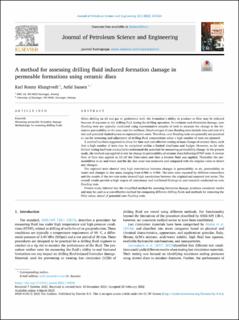| dc.contributor.author | Klungtvedt, Karl Ronny | |
| dc.contributor.author | Saasen, Arild | |
| dc.date.accessioned | 2023-03-29T12:26:28Z | |
| dc.date.available | 2023-03-29T12:26:28Z | |
| dc.date.created | 2022-03-18T12:14:55Z | |
| dc.date.issued | 2022 | |
| dc.identifier.citation | Klungtvedt, K. R., & Saasen, A. (2022). A method for assessing drilling fluid induced formation damage in permeable formations using ceramic discs. Journal of Petroleum Science and Engineering, 213, 110324. | en_US |
| dc.identifier.issn | 0920-4105 | |
| dc.identifier.uri | https://hdl.handle.net/11250/3060926 | |
| dc.description.abstract | When drilling an oil and gas or geothermal well, the formation's ability to produce or flow may be reduced because of exposure to the drilling fluid during the drilling operation. To evaluate such formation damage, core flooding tests are typically conducted using representative samples of rock to measure the change in the formation permeability in the zone near the wellbore. Disadvantages of core flooding tests include time and cost of a test and potential limited access to representative cores. Therefore, core flooding tests are generally not practical to use for screening and adjustment of drilling fluid compositions when a high number of tests are planned.
A method has been suggested to allow for time and cost-effective testing of mass change of ceramic discs, such that a high number of tests may be completed within a limited timeframe and budget. However, so far only limited testing had been conducted to understand the potential for measuring permeability change. In the present study, the method was applied to test for change in permeability of ceramic discs following HTHP tests. A reverse flow of fluid was applied to lift off the filter-cakes and then a breaker fluid was applied. Thereafter the permeabilities to air and water and the dry disc mass was measured and compared with the original value to detect any changes.
The repeated tests showed very high correlations between changes in permeability to air, permeability to water and changes in disc mass, ranging from 0.906 to 0.984. The tests were repeated by different researchers and the results of the two test-series showed high correlations between the original and repeated test series. The overall results provide a high degree of consistency and confirmed findings in past research conducted on core flooding tests.
Present study inferred that the simplified method for assessing formation damage produces consistent results and may be used as a cost-effective method for comparing different drilling fluids and methods for removing the filter cakes, ahead of potential core flooding tests. | en_US |
| dc.language.iso | eng | en_US |
| dc.publisher | Elsevier | en_US |
| dc.rights | Navngivelse 4.0 Internasjonal | * |
| dc.rights.uri | http://creativecommons.org/licenses/by/4.0/deed.no | * |
| dc.title | A method for assessing drilling fluid induced formation damage in permeable formations using ceramic discs | en_US |
| dc.type | Peer reviewed | en_US |
| dc.type | Journal article | en_US |
| dc.description.version | publishedVersion | en_US |
| dc.rights.holder | The authors | en_US |
| dc.subject.nsi | VDP::Teknologi: 500 | en_US |
| dc.source.volume | 213 | en_US |
| dc.source.journal | Journal of Petroleum Science and Engineering | en_US |
| dc.identifier.doi | 10.1016/j.petrol.2022.110324 | |
| dc.identifier.cristin | 2010796 | |
| cristin.ispublished | true | |
| cristin.fulltext | original | |
| cristin.qualitycode | 2 | |

